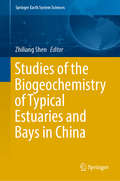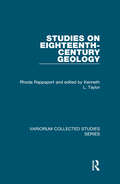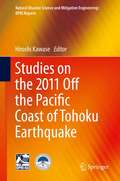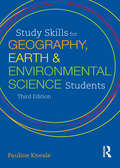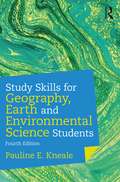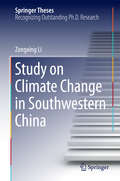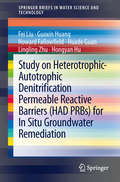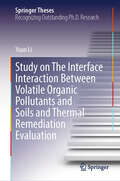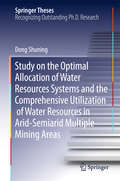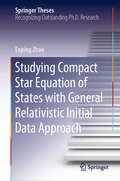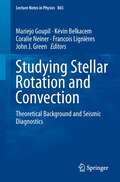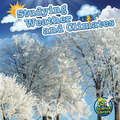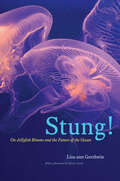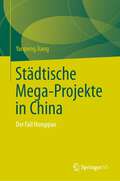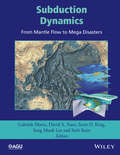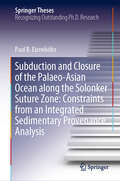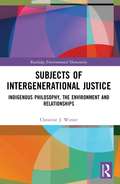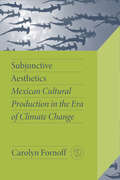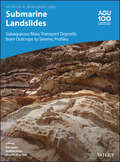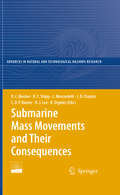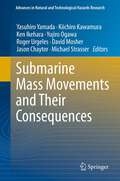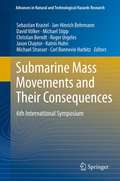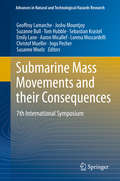- Table View
- List View
Studies of the Biogeochemistry of Typical Estuaries and Bays in China (Springer Earth System Sciences)
by Zhiliang ShenThis book presents study findings involving the Changjiang River estuary and Jiaozhou Bay, China, etc. It takes a large catchment as a combined ecosystem to study nutrients biogeochemistry and environmental aspects of the Changjiang River. Some of the findings have sparked new research directions, including systematic studies of nutrients in the Changjiang River; sources and control mechanisms of nitrogen and phosphorus in the Changjiang River and its estuary; removal and transport of nutrients in the turbidity maximum zone and upwelling area of the Changjiang estuary; long-term changes in nutrients and ecological responses in the Changjiang River estuary and Jiaozhou Bay; and a study on nutrient structure and nutrient composition of phytoplankton, which are topics at the forefront ofinternational marine The studies address different fields, such as biogeochemistry, marine chemistry, ecology, environmental science, oceanography and biology.
Studies on Eighteenth-Century Geology (Variorum Collected Studies #986)
by Rhoda Rappaport edited by TaylorIn a scholarly career spanning five decades, Rhoda Rappaport published perceptive analyses of science in the culture of early Modern Europe, France in particular, with strong emphasis on geology's early development. Of the sixteen papers in this volume, most focus on aspects of geology's cultivation during the 'long' 18th century, from the times of Hooke, Leibniz, and Fontenelle to those of Lavoisier, Werner, and Cuvier. Among the topics most closely treated here are the French mineralogical mapping project initiated by Guettard; contemporary efforts to interpret the earth historically (such as through Noah's Flood); and difficulties presented by the vocabulary often used in traditional histories of geology. Much of Rappaport's research addressed two problems prevalent within 18th-century earth science: the proper understanding of petrifactions, or fossil objects; and struggles to establish reliable knowledge of the earth's past. She also examined the chemistry of G.-F. Rouelle, which she saw as effectively an attempt at systematic comprehension of the entire mineral realm; trans-national features of scientific pursuits as illustrated in the careers of the naturalist Vallisneri and the mineralogist (and philosophe) d'Holbach; and aspects of science's promotion in France through government patronage and academic privilege.
Studies on the 2011 Off the Pacific Coast of Tohoku Earthquake
by Hiroshi KawaseThe Tohoku earthquake on March 11, 2011, officially designated the "Off the Pacific Coast of Tohoku, Japan Earthquake" by the Japan Meteorological Agency caused an unprecedentedly severe disaster in the northeastern part (Tohoku) of the Japanese island of Honshu. This first volume of the series Natural Disaster Science and Mitigation Engineering: DPRI Reports covers various aspects of investigations of scientific findings as well as issues related to the disaster and the subsequent evacuation necessitated by the earthquake. The series presents recent advances in natural disaster sciences and mitigation technologies developed in Japan, which will be valuable for the mitigation of disasters of a similar kind resulting from future events around the world.
Studies on the 2011 Off the Pacific Coast of Tohoku Earthquake (Natural Disaster Science and Mitigation Engineering: DPRI reports)
by Hiroshi KawaseThe Tohoku earthquake on March 11, 2011, officially designated the “Off the Pacific Coast of Tohoku, Japan Earthquake” by the Japan Meteorological Agency caused an unprecedentedly severe disaster in the northeastern part (Tohoku) of the Japanese island of Honshu. This first volume of the series Natural Disaster Science and Mitigation Engineering: DPRI Reports covers various aspects of investigations of scientific findings as well as issues related to the disaster and the subsequent evacuation necessitated by the earthquake. The series presents recent advances in natural disaster sciences and mitigation technologies developed in Japan, which will be valuable for the mitigation of disasters of a similar kind resulting from future events around the world.
Study Skills for Geography, Earth and Environmental Science Students
by Pauline E KnealeThere are moments in everyone's degree when you are expected to do something unfamiliar and daunting - present a seminar, go on a fieldtrip, create a wiki page, lead a lab team - and how to do it or what to expect is unclear. Studying at university requires a different approach from studying at school and this book explains this transition. Packed with practical hints, study tips, short cuts, real-life examples and careers advice, this book will prove invaluable throughout your geography, earth science or environmental science degree. Designed for all geography, earth science and environmental science students, this book provides guidance on: time management and effective research constructing essays and creating arguments giving presentations confidently undertaking fieldwork and laboratory work avoiding plagiarism and citing references correctly using e-technologies such as blogs and your university's VLE online assessment and peer feedback. This guide also explains the role of the academic and how it differs from that of a school teacher, and prepares you for the world of work by showing how the skills you learn at university today can be used in your career choice of tomorrow.
Study Skills for Geography, Earth and Environmental Science Students
by Pauline E. KnealeThis guide will help you to survive and thrive during your degree and on into the workplace. Everything you do at university can be useful in your career. Packed with practical hints, study tips, short cuts, real-life examples and careers advice, the new expanded fourth edition of this book is an invaluable resource throughout your geography, earth science or environmental science studies. This book provides guidance for successful study on many topics including: Starting as a student Being an effective researcher Presenting information effectively in posters, presentations, essays and reports Time management, well-being and ethics Field and laboratory work Assessment and feedback Written in an accessible style, this guide also explains the role of the academic, and how it differs from that of a school teacher. It prepares you for the world of work by showing how the skills you learn at university today can be used in your career choice of tomorrow.
Study on Climate Change in Southwestern China
by Zongxing LiThis thesis confirms many changes, including sharp temperature rise, interannual variability of precipitation, extreme climate events and significant decreases of sunshine duration and wind speed in southwestern China, and systemically explores the action mechanism between large-scale atmospheric circulation systems, the complicated topography, human activities and regional climate changes. This study also analyzes the response of glaciers to climate change so that on the one hand it clearly reflects the relationship between glacier morphologic changes and climate change; on the other, it reveals the mechanism of action of climate warming as a balance between energy and matter. The achievements of this study reflect a significant contribution to the body of research on the response of climate in cold regions, glaciers and human activities to a global change against the background of the typical monsoon climate, and have provided scientific basis for predictions, countermeasures against disasters from extreme weather, utilization of water and the establishment of counterplans to slow and adapt to climate change. Zongxing Li works at the Cold and Arid Region Environmental and Engineering Research Institute, Chinese Academy of Sciences, China.
Study on Heterotrophic-Autotrophic Denitrification Permeable Reactive Barriers (HAD PRBs) for In Situ Groundwater Remediation
by Fei Liu Huade Guan Lingling Zhu Hongyan Hu Guoxin Huang Howard Fallowfield"Heterotrophic-Autotrophic Denitrification Permeable Reactive Barriers (HAD PRBs) for Groundwater in Situ Remediation" is an unmatched reference work on PRBs for groundwater in situ remediation. It proposes a novel HAD PRB approach for nitrate-contaminated groundwater remediation, and provides a systematic and clear explanation of design concepts and denitrification mechanisms. The book consists of four chapters, each of which covers key aspects of HAD PRBs. It provides rich, easy-to-follow illustrations, tables and references. Unique as a comprehensive reference work on the subject, it will serve as a valuable resource for all engineers and scientists active in environmental science and engineering, groundwater science, engineering and molecular biology. Prof. Fei Liu works at China University of Geosciences (Beijing), China. Dr. Guoxin Huang works at Beijing Academy of Food Sciences, China. Both Prof. Howard Fallowfield and Prof. Huade Guan work at Flinders University, Australia. Assistant Engineer Lingling Zhu works at Geological Publishing House, China. Assistant Engineer Hongyan Hu works at Hydrogeology and Engineering Geology Prospecting Institute of Heilongjiang Province, China.
Study on The Interface Interaction Between Volatile Organic Pollutants and Soils and Thermal Remediation Evaluation (Springer Theses)
by Yuan LiFrom a microperspective, this book investigates the interface interaction between organic pollutants and soil skeleton, as well as the electrochemical response and the interface mechanical mechanism of contaminated soil in thermal environments. Considering interface behaviors and mechanisms, a one-dimensional soil column and a large-scale three-dimensional laboratory model using steam injection technology were self-developed for the first time to discuss the removal pathways and effectiveness of pollutants under heat-moisture conditions in a simulated in-situ soil stress. In addition, this book also focuses on the mechanical performance and biological resilience of the thermally remediated soil to expand the reuse scenarios of these wastes. This study effectively integrates interdisciplinary knowledge such as soil mechanics, fluid flow in porous medium, and environmental chemistry and innovatively conducts systematic research using theoretical, experimental, and numerical simulation methods to fill the gap in current research on the interaction behaviors, fate mechanisms, remediation pathways, and reuse potential of organic contaminated soils. The methodology established in this book provides a good foundation for the characterization, efficient remediation, and reutilization of organic contaminated soils, filling the gap of a single discipline in solving the issue of contaminated sites and broadening the research perspective and depth for geo-environmental engineering.
Study on the Optimal Allocation of Water Resources Systems and the Comprehensive Utilization of Water Resources in Arid-Semiarid Multiple Mining Areas
by Dong ShuningArid-semiarid regions have suffered from sharp conflicts among water resource utilization, mining, and the environmental protection. Sustainable development in these regions requires a close coordination between economy, society and the environment. Based on systematic hydrogeological investigations, laboratory and in-situ tests, and application of innovative methodologies including theoretical analysis modeling and prediction to study water resource distribution (including surface water, groundwater, mine water and coal mine domestic water) in mining areas, this dissertation provides detailed analysis of the current situation and trend of water uses in domestic supply, agriculture and industry. It evaluates the status development and utilization, evolution trend, exploitation and utilization potential of water resources in Shen-Dong Coal Mine area, one of China's extra-large coal bases. Incorporated with the long and intermediate terms' development strategies of this area, the dissertation lays out a scientific allocation scheme of water resources in different hydrological years and proposes a planning mode of water resources development and utilization and a technical scheme for comprehensive water resources utilization to provide technical supports for the optimal allocation, rational exploitation, comprehensive utilization and scientific management of water resources. This dissertation is one of the best in Chang'an University because of the volume of reliable data, defensible scientific analysis, and world significance of the research results.
Studying Compact Star Equation of States with General Relativistic Initial Data Approach (Springer Theses)
by Enping ZhouThis book focuses on the equation of state (EoS) of compact stars, particularly the intriguing possibility of the “quark star model.” The EoS of compact stars is the subject of ongoing debates among astrophysicists and particle physicists, due to the non-perturbative property of strong interaction at low energy scales. The book investigates the tidal deformability and maximum mass of rotating quark stars and triaxially rotating quark stars, and compares them with those of neutron stars to reveal significant differences. Lastly, by combining the latest observations of GW170817, the book suggests potential ways to distinguish between the neutron star and quark star models.
Studying Geography at University: How to Succeed in the First Year of Your New Degree
by Peter Hopkins Simon TateWritten by leading academics, this book is an invaluable ‘how to …’ guide to studying for a Geography degree. Written in a practical and conversational style, it offers important insights into how to succeed in the first year of your degree course, covering everything from how to succeed in assessments to how to decide where to live. Some of the information the book provides is academic and some of it is non-academic, as negotiating both is important in order to be successful in the first year of a Geography degree. Studying Geography at University is ideal for those in the early stages of applying to university. Each chapter offers hints and tips and gives practical real-world insights into becoming a successful geography student that will enrich applications, open days and visit days. It is also possible to dip into the chapter summaries, ‘What Do Students Say?’ and ‘Top Tip’ boxes only. Written by current students, from a range of institutions, these provide unique insights into the book's key points. Current students should also keep and refer to the book as an invaluable guide through the first few months of their degree. This guide is a must-read for anyone starting their studies in Human Geography, Physical Geography, Environmental Science or any other related subject at university.
Studying Stellar Rotation and Convection
by John J. Green Coralie Neiner Kévin Belkacem Francois Lignières Mariejo GoupilThis volume synthesizes the results of work carried out by several international teams of the SIROCO (Seismology for Rotation and Convection) collaboration. It provides the theoretical background required to interpret the huge quantity of high-quality observational data recently provided by space experiments such as CoRoT and Kepler. Asteroseismology allows astrophysicists to test, to model and to understand stellar structure and evolution as never before. The chapters in this book address the two groups of topics summarized as "Stellar Rotation and Associated Seismology" as well as "Stellar Convection and Associated Seismology". The book offers the reader solid theoretical background knowledge and adapted seismic diagnostic techniques.
Studying Weather and Climates (My Science Library)
by Conrad J. StoradIntermediate Readers Explore The Difference Between Climate And Weather.
Stung!: On Jellyfish Blooms and the Future of the Ocean
by Lisa-ann Gershwin“The world of jellyfish is brought alive as you never imagined it could be by Lisa-ann Gershwin in this engaging, gripping, and often funny book.” —Callum Roberts, author of The Ocean of LifeAs our oceans become increasingly inhospitable to life, there is one creature that is thriving in this seasick environment: the beautiful, dangerous, and now incredibly numerous jellyfish. As foremost jellyfish expert Lisa-ann Gershwin describes in Stung!, the jellyfish population bloom is highly indicative of the tragic state of the world’s ocean waters, while also revealing the incredible tenacity of these remarkable creatures.Despite their often dazzling appearance, jellyfish are simple creatures with simple needs: namely, fewer predators and competitors, warmer waters to encourage rapid growth, and more places for their larvae to settle and grow. In general, oceans that are less favorable to fish are more favorable to jellyfish, and these are the very conditions that we are creating through mechanized trawling, habitat degradation, coastal construction, pollution, and climate change.Despite their role as harbingers of marine destruction, jellyfish are truly enthralling creatures in their own right, and in Stung!, Gershwin tells stories of jellyfish both attractive and deadly while illuminating many interesting and unusual facts about their behaviors and environmental adaptations. She takes readers back to the Proterozoic era, when jellyfish were the top predator in the marine ecosystem—at a time when there were no fish, no mammals, and no turtles; and she explores the role jellies have as middlemen of destruction, moving swiftly into vulnerable ecosystems. The story of the jellyfish, as Gershwin makes clear, is also the story of the world’s oceans, and Stung! provides a unique and urgent look at their inseparable histories—and future.
Städtische Mega-Projekte in China: Der Fall Hongqiao
by Yanpeng JiangDieses Buch ist die erste systematische Darstellung von städtischen Megaprojekten in China, die sich mit deren Bau, Betrieb und Planung befasst. Es ist eine detaillierte Untersuchung der Planung und des Baus von Hongqiao und seiner Auswirkungen auf die Anwohner. Kurz gesagt, das Ziel dieses Buches ist es, den Planungs- und Entwicklungsprozess der Verkehrs- und Handelszone Hongqiao zu untersuchen, ihre Beziehung zur Stadtentwicklung und zur räumlichen Umstrukturierung in Shanghai zu erforschen und dabei die Art des städtischen Wandels im heutigen China zu kommentieren und zu kritisieren, der als eigentums- und infrastrukturgetrieben charakterisiert wird. Städtische Megaprojekte sind wohl das Symbol des unternehmerischen Urbanismus schlechthin, und es ist kein Zufall, dass sie in der ganzen Welt, nicht zuletzt in Ostasien, zu einem vertrauten Bestandteil der städtischen Szene geworden sind. Sie können sowohl als Folge der Deindustrialisierung führender Städte, zunächst in Nordamerikaund Europa und dann in Ostasien, als Reaktion auf den Übergang der Volkswirtschaften zum globalisierten Neoliberalismus betrachtet werden. Dieses Buch bietet einen umfassenden Überblick über die Hauptmerkmale der in Hongqiao gebildeten landbasierten städtischen Wachstumskoalition, indem es das Hongqiao-Projekt im Detail vorstellt und das jüngste Beispiel des wettbewerbsorientierten Ansturms auf städtische Projekte in Chinas größten Städten skizziert, der zur Ausbreitung neuer Finanzdistrikte in Beijing und Guangzhou geführt hat.
Subduction Dynamics: From Mantle Flow to Mega Disasters
by Seth Stein Gabriele Morra Sang Mook Lee Scott D. King David A. YuenSubduction dynamics has been actively studied through seismology, mineral physics, and laboratory and numerical experiments. <P><P>Understanding the dynamics of the subducting slab is critical to a better understanding of the primary societally relevant natural hazards emerging from our planetary interior, the megathrust earthquakes and consequent tsunamis. Subduction Dynamics is the result of a meeting that was held between August 19 and 22, 2012 on Jeju island, South Korea, where about fifty researchers from East Asia, North America and Europe met. Chapters treat diverse topics ranging from the response of the ionosphere to earthquake and tsunamis, to the origin of mid-continental volcanism thousands kilometers distant from the subduction zone, from the mysterious deep earthquakes triggered in the interior of the descending slabs, to the detailed pattern of accretionary wedges in convergent zones, from the induced mantle flow in the deep mantle, to the nature of the paradigms of earthquake occurrence, showing that all of them ultimately are due to the subduction process. Volume highlights include: · Multidisciplinary research involving geology, mineral physics, geophysics and geodynamics · Extremely large-scale numerical models with state-of-the art high performance computing facilities · Overview of exceptional three-dimensional dynamic representation of the evolution of the Earth interiors and of the earthquake and subsequent tsunami dynamics · Global risk assessment strategies in predicting natural disasters This volume is a valuable contribution in earth and environmental sciences that will assist with understanding the mechanisms behind plate tectonics and predicting and mitigating future natural hazards like earthquakes, volcanoes and tsunamis.
Subduction and Closure of the Palaeo-Asian Ocean along the Solonker Suture Zone: Constraints from an Integrated Sedimentary Provenance Analysis (Springer Theses)
by Paul R. EizenhöferThis Ph.D. thesis attempts to decipher the closure of the Palaeozoic Palaeo-Asian Ocean along the enigmatic Solonker Suture in East Asia adopting a methodology that integrates geochemical and geochronological data from Palaeozoic sedimentary and volcanic rocks in the region. It provides an in-detail but also broad insight into the Palaeozoic to early Mesozoic tectonic evolution of the region, not only pin-pointing the debated location of the Solonker Suture but also the timing of final disappearance of the Palaeo-Asian Ocean during Permian to Early Triassic times. The results have led to propose a tectonic ‘soft-collision’ model for the amalgamation of the North China Craton and the Mongolian Terranes in northern Asia explaining the general absence of geologic features characteristic for continent-continent collisions such as the occurrence of regional-scale high-grade metamorphic rocks, ophiolite belts and fold-thrust structures. This new model may serve as a blueprint for the tectonic evolution of similar suture zones that are characterized by the absence of typical collision related lithologies and structures. The thesis is particularly useful as a guide for researchers who seek an in-depth understanding of the Palaeozoic to early Mesozoic tectonic evolution of northern China and Central Asia along the Solonker Suture.
Subjects of Intergenerational Justice: Indigenous Philosophy, the Environment and Relationships (Routledge Environmental Humanities)
by Christine J. WinterThis book challenges mainstream Western IEJ (intergenerational environmental justice) in a manner that privileges indigenous philosophies and highlights the value these philosophies have for solving global environmental problems. Divided into three parts, the book begins by examining the framing of Western liberal environmental, intergenerational and indigenous justice theory and reviews decolonial theory. Using contemporary case studies drawn from the courts, film, biography and protests actions, the second part explores contemporary Māori and Aboriginal experiences of values-conflict in encounters with politics and law. It demonstrates the deep ontological rifts between the philosophies that inform Māori and Aboriginal intergenerational justice (IJ) and those of the West that underpin the politics and law of these two settler states. Existing Western IEJ theories, across distributional, communitarian, human rights based and the capabilities approach to IJ, are tested against obligations and duties of specific Māori and Aboriginal iwi and clans. Finally, in the third part, it explores the ways we relate to time and across generations to create regenerative IJ. Challenging the previous understanding of the conceptualization of time, it posits that it is in how we relate—human to human, human to nonhuman, nonhuman to human—that robust conceptualization of IEJ emerges. This volume presents an imagining of IEJ which accounts for indigenous norms on indigenous terms and explores how this might be applied in national and international responses to climate change and environmental degradation. Demonstrating how assumptions in mainstream justice theory continue to colonise indigenous people and render indigenous knowledge invisible, this book will be of great interest to students and scholars of environmental and intergenerational philosophy, political theory, indigenous studies and decolonial studies, and environmental humanities more broadly.
Subjunctive Aesthetics: Mexican Cultural Production in the Era of Climate Change (Critical Mexican Studies)
by Carolyn FornoffDuring the twenty-first century, Mexico has escalated extractive concessions at the same time that it has positioned itself as an international leader in the fight against climate change. Cultural production emergent from this contradiction frames this impasse as a crisis of imagination. Subjunctive Aesthetics studies how contemporary writers, filmmakers, and visual artists grapple with the threat that climate change and extractivist policies pose to Mexico's present and future. It explores how artists rise to the challenge of envisioning alternative forms of territoriality (ways of being in relation to the environment) through strategies ranging from rewriting to counterfactual speculation. Whereas ecocritical studies have often focused on art's evidentiary role—its ability to visualize and prove the urgency of environmental damage—author Carolyn Fornoff argues that what unites the artists under consideration is their use of more hypothetical, uncertain representational modes, or "subjunctive aesthetics." In English, the subjunctive is a grammatical mode that articulates the imagined, desired, and possible. In the Spanish language, it is even more widely used to express doubts, denials, value judgments, and emotions. Each chapter of Subjunctive Aesthetics takes up one of these modalities to examine how Mexican artists, writers, and filmmakers activate approaches to the planet not just as it is, but as it could be or should be.
Submarine Landslides: Subaqueous Mass Transport Deposits from Outcrops to Seismic Profiles (Geophysical Monograph Series #247)
by Kei Ogata Andrea Festa Gian Andrea PiniAn examination of ancient and contemporary submarine landslides and their impact Landslides are common in every subaqueous geodynamic context, from passive and active continental margins to oceanic and continental intraplate settings. They pose significant threats to both offshore and coastal areas due to their frequency, dimensions, and terminal velocity, capacity to travel great distances, and ability to generate potentially destructive tsunamis. Submarine Landslides: Subaqueous Mass Transport Deposits from Outcrops to Seismic Profiles examines the mechanisms, characteristics, and impacts of submarine landslides. Volume highlights include: Use of different methodological approaches, from geophysics to field-based geology Data on submarine landslide deposits at various scales Worldwide collection of case studies from on- and off-shore Potential risks to human society and infrastructure Impacts on the hydrosphere, atmosphere, and lithosphere
Submarine Mass Movements and Their Consequences
by Jason Chaytor Roger Urgeles Lorena Moscardelli Chris Baxter Craig Shipp D. C. Mosher Homa LeeRecent global events such as the devastating 1998 Papua New Guinea tsunami, the 2004 Sumatran tsunami and the 2006 SE Asia undersea network cable failure underscore the societal and economic effects of submarine mass movements. These events call upon the scientific community to understand submarine mass movement processes and consequences to assist in hazard assessment, mitigation and planning. Additionally, submarine mass movements are beginning to be recognized as prevalent in continental margin geologic sections. As such, they represent a significant if not dominant role in margin sedimentary processes. They also represent a potential hazard to hydrocarbon exploration and development, but also represent exploration indicators and targets. This volume consists of a collection of the latest scientific research by international experts in geological, geophysical, engineering and environment aspects of submarine mass failures, focussed on understanding the full spectrum of challenges presented by submarine mass movements and their consequences.
Submarine Mass Movements and Their Consequences
by Yujiro Ogawa Jason Chaytor Michael Strasser Roger Urgeles David Mosher Ken Ikehara Kiichiro Kawamura Yasuhiro YamadaSubmarine mass movements represent major offshore geohazards due to their destructive and tsunami-generation potential. This potential poses a threat to human life as well as to coastal, nearshore and offshore engineering structures. Recent examples of catastrophic submarine landslide events that affected human populations (including tsunamis) are numerous; e.g., Nice airport in 1979, Papua-New Guinea in 1998, Stromboli in 2002, Finneidfjord in 1996, and the 2006 and 2009 failures in the submarine cable network around Taiwan. The Great East Japan Earthquake in March 2011 also generated submarine landslides that may have amplified effects of the devastating tsunami. Given that 30% of the World's population live within 60 km of the coast, the hazard posed by submarine landslides is expected to grow as global sea level rises. This elevated awareness of the need for better understanding of submarine landslides is coupled with great advances in submarine mapping, sampling and monitoring technologies. Laboratory analogue and numerical modeling capabilities have also developed significantly of late. Multibeam sonar, 3D seismic reflection, and remote and autonomous underwater vehicle technologies provide hitherto unparalleled imagery of the geology beneath the oceans, permitting investigation of submarine landslide deposits in great detail. Increased and new access to drilling, coring, in situ measurements and monitoring devices allows for ground-thruth of geophysical data and provides access to samples for geotechnical laboratory experiments and information on in situ strength and effective stress conditions of underwater slopes susceptible to fail. Great advances in numerical simulation techniques of submarine landslide kinematics and tsunami propagation, particularly since the 2004 Sumatra tsunami, have also lead to increased understanding and predictability of submarine landslide consequences. This volume consists of the latest scientific research by international experts in geological, geophysical, engineering and environmental aspects of submarine mass failure, focused on understanding the full spectrum of challenges presented by submarine mass movements and their consequences.
Submarine Mass Movements and Their Consequences: 6th International Symposium
by Carl Bonnevie Harbitz Christian Berndt David Völker Jan-Hinrich Behrmann Jason Chaytor Katrin Huhn Michael Stipp Michael Strasser Roger Urgeles Sebastian KrastelSubmarine mass movements are a hidden geohazard with large destructive potential for submarine installations and coastal areas. This hazard and associated risk is growing in proportion with increasing population of coastal urban agglomerations, industrial infrastructure, and coastal tourism. Also, the intensified use of the seafloor for natural resource production, and deep sea cables constitutes an increasing risk. Submarine slides may alter the coastline and bear a high tsunamogenic potential. There is a potential link of submarine mass wasting with climate change, as submarine landslides can uncover and release large amounts greenhouse gases, mainly methane, that are now stored in marine sediments. The factors that govern the stability of submarine slopes against failure, the processes that lead to slope collapses and the collapse processes by themselves need to be better understood in order to foresee and prepare society for potentially hazardous events. This book volume consists of a collection of cutting edge scientific research by international experts in the field, covering geological, geophysical, engineering and environmental aspects of submarine slope failures. The focus is on understanding the full spectrum of challenges presented by this major coastal and offshore geohazard.
Submarine Mass Movements and their Consequences
by Sebastian Krastel Geoffroy Lamarche Joshu Mountjoy Suzanne Bull Tom Hubble Emily Lane Aaron Micallef Lorena Moscardelli Christof Mueller Ingo Pecher Susanne WoelzThis book is a comprehensive collection of state-of-the-art studies of seafloor slope instability and their societal implications. The volume captures the most recent and exciting scientific progress made in this research field. As the world's climate and energy needs change, the conditions under which slope instability occurs and needs to be considered, are also changing. The science and engineering of submarine - or more widely subaqueous - mass movements is greatly benefiting from advances in seafloor and sub-seafloor surveying technologies. Ultra-high-resolution seafloor mapping and 3D seismic reflection cubes are becoming commonly available datasets that are dramatically increasing our knowledge of the mechanisms and controls of subaqueous slope failure. Monitoring of slope deformation, repeat surveying and deep drilling, on the other hand, are emerging as important new techniques for understanding the temporal scales of slope instability. In essence, rapid advances in technology are being readily incorporated into scientific research and as a result, our understanding of submarine mass movements is increasing at a very fast rate. The volume also marks the beginning of the third IGCP project for the submarine mass movement research community, IGCP-640 S4SLIDE (Significance of Modern and Ancient Submarine Slope LandSLIDEs). The Submarine Mass Movements and Their Consequences symposium is the biannual meeting under the IGCP umbrella.
